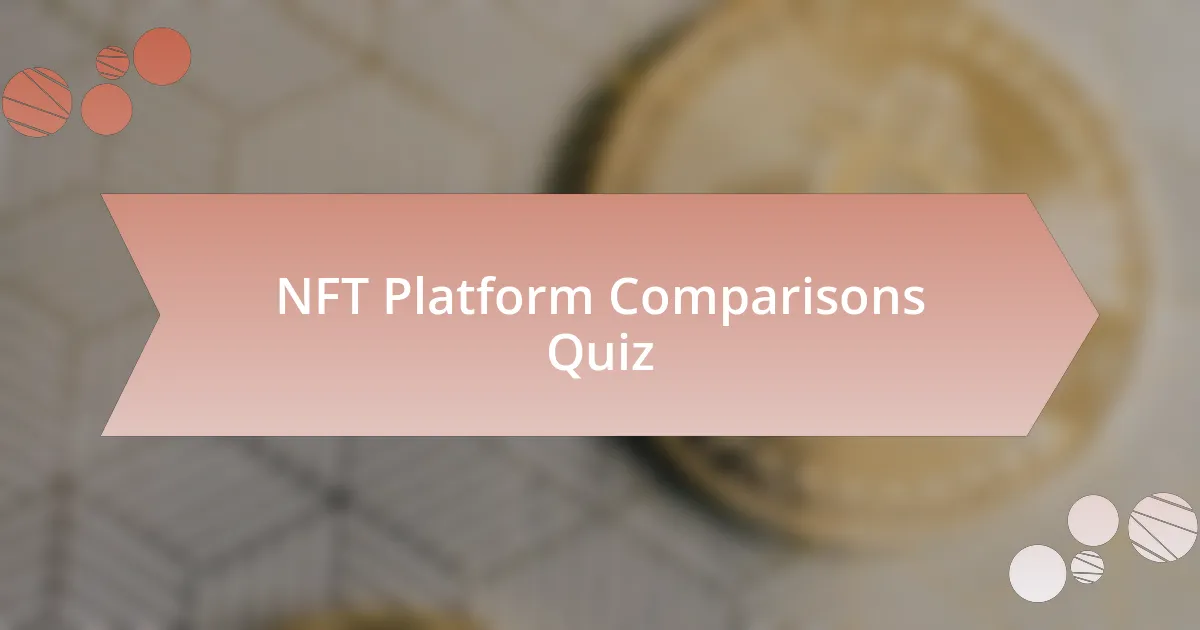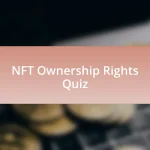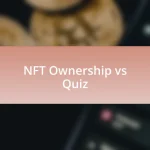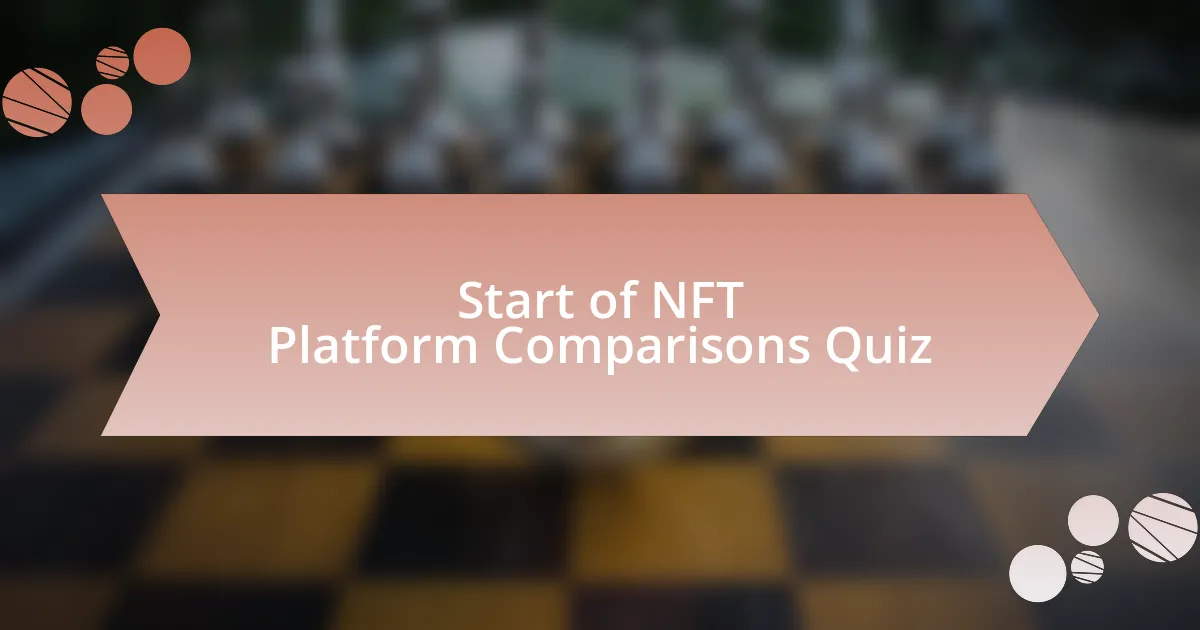
Start of NFT Platform Comparisons Quiz
1. Which NFT marketplace is the largest all-in-one platform?
- OpenSea
- Mintable
- Rarible
- Nifty Gateway
2. Which NFT marketplace has dethroned OpenSea as the largest by trading volume?
- Rarible
- Blur
- Nifty Gateway
- Magic Eden
3. What blockchain does Blur focus on exclusively?
- Ethereum
- Solana
- Cardano
- Bitcoin
4. Which Solana NFT marketplace is decentralized and has high liquidity?
- NFT Hub
- Solana Art
- Magic Eden
- DigitalEye
5. What is the primary focus of Gemini’s Nifty Gateway?
- Generic digital assets
- Free NFT minting
- Decentralized trading
- Curated NFT art
6. Which platform is the go-to for trading and storing Bitcoin NFTs?
- OpenSea
- Nifty Gateway
- Rarible
- UniSat
7. Which blockchain networks does OpenSea support?
- Ethereum, Polygon, Solana, Arbitrum, Binance’s BNB Chain, Avalanche, Base, and Klaytn.
- Ethereum, Ripple, Cardano, Polkadot, Dogecoin.
- Ethereum, Cosmos, Harmony, Neo, Algorand.
- Ethereum, Bitcoin, Litecoin, Stellar, Tezos.
8. What is the transaction fee charged by OpenSea?
- 3.0%
- 2.5%
- 1.5%
- 5.0%
9. How many integrations does OpenSea support?
- 10 tools and wallets
- Over 16 tools and wallets
- 5 tools and wallets
- 25 tools and wallets
10. Which marketplace is known for its emphasis on high-quality, limited-edition NFTs?
- Nifty Gateway
- Rarible
- OpenSea
- Mintable
11. Which platform is geared towards individuals looking to trade digital items and earn cryptocurrency?
- Nifty Gateway
- Mintable
- OpenSea
- Rarible
12. What is the primary focus of Rarible?
- E-commerce site for selling physical merchandise.
- Creator-focused platform for creating, selling, and collecting digital items secured on the blockchain.
- Social networking platform for sharing art and music.
- Gaming platform for developing video games.
13. Which marketplace offers live online training to its users?
- UniSat
- Mintable
- Nifty Gateway
- OpenSea
14. How many integrations does Mintable support?
- 5
- 8
- 3
- 10
15. How many integrations does Nifty Gateway support?
- 10
- 3
- 2
- 5
16. How many integrations does Rarible support?
- Exactly 12
- Less than 5
- Around 8
- Over 10
17. What is the primary difference between NFTs and cryptocurrencies?
- Decentralization
- Market volatility
- Supply cap
- Fungibility
18. Can an individual exchange an NFT for another?
- Only for a fee
- Only in a marketplace
- Yes
- No
19. What is the focus of cryptocurrencies?
- Charity funding
- Traditional banking
- Physical goods
- Economic value
20. What is NFT digital art?
- Physical paintings converted into digital form.
- Unique digital files that cannot be duplicated easily.
- Standard cryptocurrencies traded on exchanges.
- Regular digital files that can be shared.
21. What is an NFT drop?
- A free distribution of cryptocurrency to all users.
- An auction for physical art pieces in a gallery.
- The launch of a non-fungible token with a specific date and time for minting.
- A sale of fungible tokens on a random date.
22. What is the recommended practice for NFT drops?
- Use of purchase limits applicable to different NFTs.
- Drop NFTs without any prior announcement.
- Allow unlimited purchases for all buyers.
- Release NFTs randomly without scheduling.
23. Can NFT metadata be changed?
- Metadata is immutable and unchangeable.
- Only if the owner changes it, and the changes are reflected on the blockchain.
- It can only be changed by the marketplace.
- No changes can be made once created.
24. Are NFTs subject to legal risks?
- No
- Only for artists
- Yes
- Sometimes
25. Which blockchain does UniSat support?
- Binance
- Ethereum
- Solana
- Bitcoin ordinal
26. Which platform is an auction house featuring Bitcoin ordinal collections?
- Christie`s
- Sotheby’s
- eBay
- CoinMarketCap
27. What types of digital assets does OpenSea offer?
- Digital art, domain names, virtual worlds, and trading cards.
- Online courses, merchandise, social media accounts, and music albums.
- Streaming services, blog posts, photo collections, and e-books.
- Clothing, accessories, digital tickets, and domain hosting.
28. What cryptocurrencies are accepted on OpenSea?
- Cardano (ADA), Neo (NEO), MATIC, FIL, ZRX
- Stellar (XLM), Dogecoin (DOGE), TRON (TRX), LINK
- Ethereum (ETH/WETH), AVAX, USDC, KLAY, DAI
- Bitcoin (BTC), XRP, LTC, AAVE, DOT
29. What is the fee structure for OpenSea on secondary sales?
- 10.0%
- 5.0%
- 2.5%
- 1.0%
30. What is the fee structure for OpenSea on primary drops?
- Between 2.5% and 10%
- 1%
- 15%
- 5%
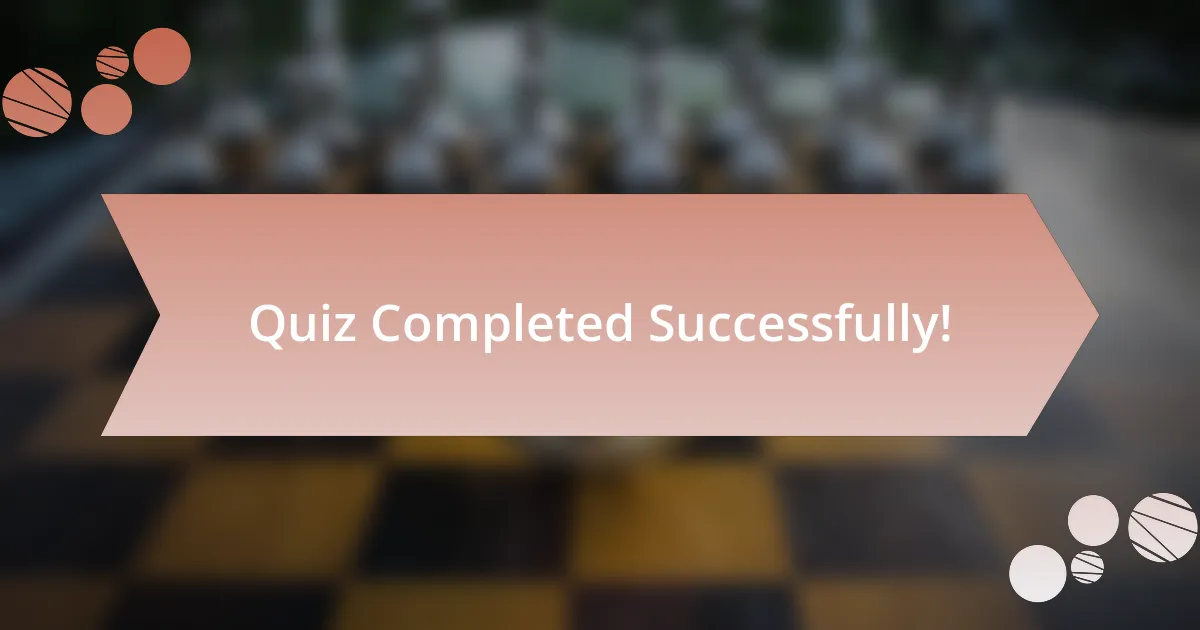
Quiz Completed Successfully!
Congratulations on completing the quiz on NFT Platform Comparisons! We hope you found the process engaging and informative. Through this quiz, you have likely gained valuable insights into the various platforms available for buying, selling, and creating NFTs. Understanding these platforms can empower you to make informed decisions in the ever-evolving world of digital assets.
As you navigated through the questions, you might have discovered the strengths and weaknesses of leading NFT platforms. This knowledge can help you identify which platform best suits your needs, whether you’re an artist, a collector, or an investor. You may have also learned about critical factors such as user experience, fees, and community support, which are essential when choosing a platform.
If you’re interested in delving deeper into this topic, we invite you to check the next section on this page regarding NFT Platform Comparisons. Here, you will find comprehensive information that can further enhance your understanding. Stay curious and keep exploring the fascinating world of NFTs!
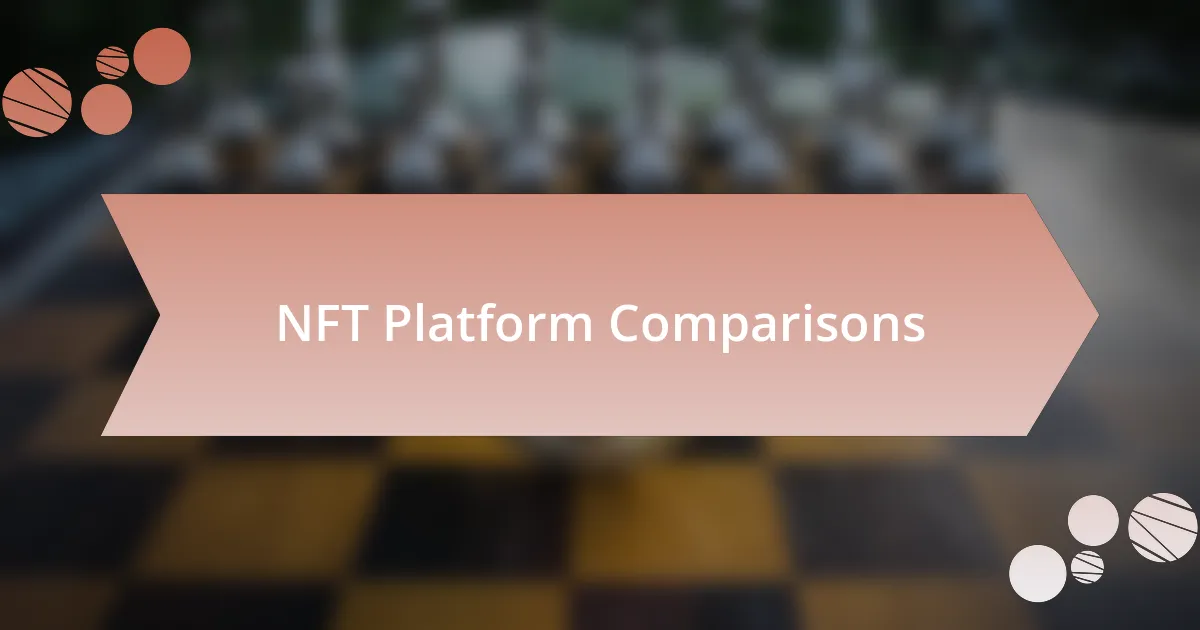
NFT Platform Comparisons
Overview of NFT Platforms
NFT platforms are digital marketplaces that facilitate the creation, buying, and selling of non-fungible tokens (NFTs). These tokens represent ownership of unique assets, ranging from digital art to virtual real estate. NFT platforms vary significantly in features, user experience, and technology. They are essential for artists, collectors, and investors seeking to engage with blockchain-based digital assets. Major platforms include OpenSea, Rarible, and Foundation, each offering different tools and functionalities.
Key Features to Consider in NFT Platforms
When comparing NFT platforms, key features include blockchain support, user interface, transaction fees, and community engagement. Blockchain support determines the security and ownership verification of assets. The user interface influences ease of use, particularly for newcomers. Transaction fees can impact profitability for sellers, as these fees vary widely among platforms. Community engagement reflects the platform’s popularity and the potential audience for creators.
Popular NFT Platforms and Their Strengths
OpenSea, Rarible, and Foundation stand out among NFT platforms. OpenSea is the largest marketplace, boasting a wide range of digital assets and low entry barriers. Rarible emphasizes community governance, allowing users to influence future developments through a token-based voting system. Foundation focuses on artists, providing a curated experience that promotes unique digital art and emerging creators.
Assessing NFT Platform Security and Reliability
Security and reliability are critical when choosing an NFT platform. This includes evaluating the underlying blockchain technology, smart contract audits, and user reviews. Platforms built on Ethereum often benefit from its robust security features. Additionally, reputable platforms will have undergone security audits to safeguard user transactions. Evaluating how platforms handle user data and the likeliness of hacks is also crucial for ensuring trust.
Future Trends in NFT Platforms
Future trends in NFT platforms include increased integration with virtual and augmented reality, enhanced user experiences, and greater sustainability initiatives. As the metaverse expands, platforms are expected to incorporate immersive experiences for buying and selling NFTs. Additionally, sustainable practices are becoming important, with platforms exploring eco-friendly blockchain alternatives. These trends indicate a growing adaptation of NFT platforms to evolving market demands.
What are NFT platforms?
NFT platforms are online marketplaces where users can create, buy, sell, and trade non-fungible tokens (NFTs). These tokens represent unique digital assets, such as artwork, music, or virtual real estate. Popular platforms include OpenSea, Rarible, and Foundation, each offering different features and capabilities for creators and collectors.
How do NFT platforms operate?
NFT platforms operate through blockchain technology, enabling users to mint, buy, or sell NFTs securely. Users typically connect a digital wallet, allowing them to manage their assets. Each transaction is recorded on the blockchain, ensuring transparency and ownership verification. Platforms derive revenue from transaction fees charged on sales.
Where can I find NFT platforms?
You can find NFT platforms by searching online or visiting popular cryptocurrency exchange sites. Many NFT platforms are integrated into existing blockchain ecosystems, such as Ethereum or Binance Smart Chain. Examples of accessible platforms include OpenSea (opensea.io), Rarible (rarible.com), and Mintable (mintable.app).
When did NFT platforms become popular?
NFT platforms gained significant popularity around 2020, alongside the rise of digital art and gaming assets. The landmark sale of the digital artwork “Everydays: The First 5000 Days” by Beeple in March 2021 for $69 million brought massive attention to the market. This event catalyzed interest in NFT trading and the development of various platforms.
Who can use NFT platforms?
Anyone with internet access and a compatible digital wallet can use NFT platforms. This includes artists, collectors, and investors. Artists can create and sell their work, while collectors can purchase and trade NFTs. The accessibility of these platforms has attracted a diverse user base, contributing to the growth of the NFT market.

